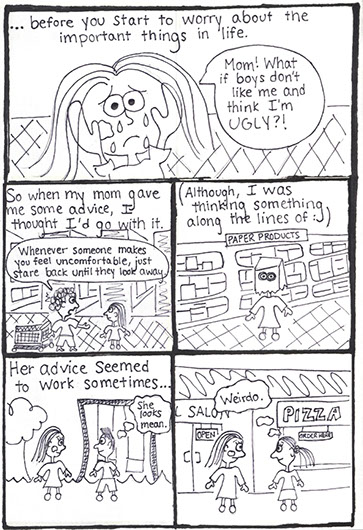One Woman's Story Of "Recovering From Psychiatry"
Laura Delano grew up in a wealthy Connecticut suburb in a family of high achievers. She was a nationally ranked squash player and student body president. But in her teen years, life got more complicated as she struggled with her own identity and felt burdened by the pressures she felt from her environment. She started to act out, cut herself, and was sent to a psychiatrist by her parents. At 14, she was diagnosed with bipolar disorder and prescribed powerful psychiatric drugs, including the mood stabilizer Depakote and Prozac.
With medication side effects leading to additional problems and “symptoms” which in turn led to more medications, Laura says she began to lose herself. She was defined by the diagnoses she continued to collect: bipolar disorder, borderline personality disorder, substance abuse disorder and binge eating disorder. She was taking up to five psychoactive substances at a time, including an anti-depressant, an anti-psychotic, a mood stabilizer and an anxiolytic (anti-anxiety agent).
Her early twenties were marked by multiple psychiatric hospitalizations and ultimately a suicide attempt. Her only identity was a self-described "professional mental patient."
But then things began to change.
Over five years ago, Laura weaned herself off psychiatric drugs and shed her diagnostic labels. For her, this has been a spiritual journey involving the cultivation of self-acceptance, self-love and honesty. “It is the hardest thing I have ever done,” she says, but she now feels happier, more connected and more engaged in the world.
Personally, I have been moved by Laura’s story. As a practicing internist, I often rely on psychiatric diagnoses and medications. In my clinical practice, I have seen psychiatric medications reduce suffering and save lives. But it has been useful to step back and reconsider my filter on these issues.
From day one of medical training, we are taught to fit our patients into neat diagnostic categories whenever possible. The goal of our patient interactions, we learn, is to sift through and distill all that we see and hear in order to hone in on a diagnosis. This categorization can be helpful in directing our care, of course, but it can also be limiting, and even dangerous. Rarely does a diagnosis fit perfectly, yet all too often in our culture one’s diagnosis becomes indistinguishable from one’s identity. Labels have power.
With mental illness, diagnostic criteria are particularly difficult to define and identify. Truthfully, our current understanding of the brain and the biochemistry behind mental illness is limited. There are no clear markers to measure and quantify. Instead, we must rely on subjective interpretation of behavior.
And yet, psychiatric labels abound. It is estimated that one in four adults, or approximately 61.5 million individuals, and one in five teens between the ages of 13 and 18, meets criteria for a diagnosis of mental illness within a given year.
Laura would say that the medical establishment often miscategorizes healthy struggling as pathology, and that this is especially true in adolescence, when some degree of acting out is to be expected. She believes this is what happened to her.
Today, more than 20% of Americans regularly take psychotropic medications—chemical substances that alter brain chemistry and function, and ultimately emotions and behavior. In 2010, sale of such medications amounted to more than seventy billion dollars in the US, and prescription rates continue to climb for both children and adults.
Again, our scientific understanding of how these medications work is shockingly poor. It has something to do with a soup of neurotransmitters—serotonin, dopamine, norepinephrine—but we haven’t nailed down the exact mechanisms of action.
Can we really say with complete confidence that mental illness is primarily the cause of chemical imbalance in the brain? I don’t think so. Not yet anyway.
Moreover, the list of negative side-effects of these medications seems almost endless—weight gain, cognitive impairment, drowsiness, dry mouth, higher rates of diabetes, increased suicidality, sexual dysfunction to name a few--and studies suggest that long term use of such substances may actually lead to increased disability over time.
Most concerning of all is the increasing and often “off-label” (i.e., not FDA approved) use of such medications in children. For instance, the number of children receiving atypical, or second generation, anti-psychotics doubled between 2001 and 2010. Disturbingly, children on Medicaid are four times more likely to receive these drugs than kids with private insurance. What are we doing to these developing brains? Again, we really don’t know.
I am not suggesting that all psychiatric diagnoses are wrong, or that every one on psychiatric drugs should stop taking them. Even Laura would say that it would be dangerous to stop taking these drugs abruptly, without a lot of planning, personal reflection, and supports in place. I still believe that psychiatric drugs can be helpful at times, and I will continue to prescribe them, but I will do so less frequently and with more awareness and caution.
All of us, and doctors in particular, need to ask questions about our current frameworks of understanding and about our assumptions. Laura’s story has reminded me of this. Every patient is unique, and there is still so much we don’t know.
A version of this story was originally published on WBUR CommonHealth Blog March 16th, 2016.
Contact Laura:
Laura on Facebook: https://www.facebook.com/lfdelano
Laura on Twitter: https://twitter.com/LauraDelano
Recovering from Psychiatry on Facebook: https://www.facebook.com/recoveringfrompsychiatry/
Laura's Suggested Resources:
www.madinamerica.com-- Mad in America
www.cepuk.org-- Council for Evidence-Based Psychiatry (UK)
www.beyondmeds.com-- Beyond Meds
www.recovery-road.org-- Recovery Road
Find suggested books here


















